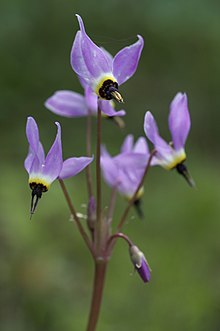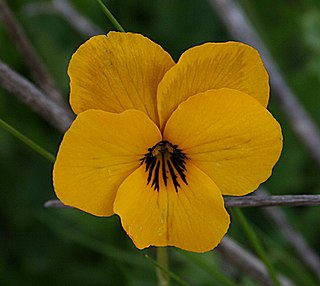
Viola pedunculata, the California golden violet, Johnny jump up, or yellow pansy, is a perennial yellow wildflower of the coast and coastal ranges in California and northwestern Baja California. The common name "Johnny jump up" is usually associated with Viola tricolor however, the introduced garden annual.

Arctostaphylos uva-ursi is a plant species of the genus Arctostaphylos widely distributed across circumboreal regions of the subarctic Northern Hemisphere. Kinnikinnick is a common name in Canada and the United States. Growing up to 30 centimetres in height, the leaves are evergreen. The flowers are white to pink and the fruit is a red berry.

Fritillaria affinis, the chocolate lily, is a highly variable species of flowering plant in the lily family Liliaceae native to western North America.

Primula sect. Dodecatheon is a section of herbaceous flowering plants in the family Primulaceae. Primula species in this section were formerly placed in a separate genus, Dodecatheon. The species have basal clumps of leaves and nodding flowers that are produced at the top of tall stems rising from where the leaves join the crown. The genus is largely confined to North America and part of northeastern Siberia. Common names include shooting star, American cowslip, mosquito bills, mad violets, and sailor caps. A few species are grown in gardens for their showy and unique flower display.

Eriophyllum lanatum, with the common names common woolly sunflower, Oregon sunshine and golden yarrow, is a common, widespread, North American plant in the family Asteraceae.

Rubus parviflorus, commonly called thimbleberry, is a species of Rubus native to northern temperate regions of North America. The plant has large hairy leaves and no thorns. It bears edible red fruit similar in appearance to a raspberry, but shorter, almost hemispherical. It has not been commercially developed for the retail berry market, but is cultivated for landscapes.
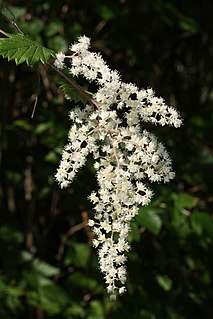
Holodiscus discolor, commonly known as ocean spray or oceanspray, creambush, or ironwood, is a shrub of western North America.
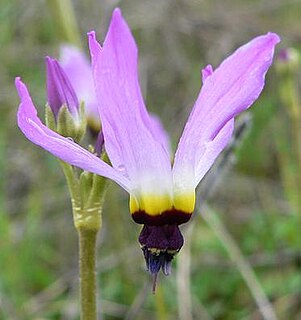
Primula clevelandii, with the common name of Padre's shooting star, is a species of primrose.

Dicentra formosa is a flowering plant with fern-like leaves and an inflorescence of drooping pink, purple, yellow or cream flowers native to the Pacific Coast of North America.

Primula meadia, the shooting star or eastern shooting star, is a species of flowering plant in the primrose family Primulaceae. It is native to the eastern United States and Canada, spanning north from Manitoba and New York, south to Texas and Florida.

Primula pauciflora, the pretty shooting star, few-flowered shooting star, dark throat shooting star or prairie shooting star, is a species of flowering plant in the primula family Primulaceae. It is a widespread and very variable species, native to western North America, from Subarctic America to Mexico, often in xeric and desert habitats. It is found in the Great Basin Deserts and Mojave Desert. Its synonyms include Dodecatheon pauciflorum and Dodecatheon pulchellum.

Primula tetrandra, synonyms Dodecatheon tetrandrum and Dodecatheon alpinum, is a perennial plant in the primrose family, Primulaceae, known by the common name alpine shooting star.

Primula conjugens, synonym Dodecatheon conjugens, is a species of flowering perennial plant in the primrose family, known by the common name Bonneville shooting star.

Primula jeffreyi, synonym Dodecatheon jeffreyi, is a species of flowering plant in the primrose family known by the common names Sierra shooting star, Jeffrey's shooting star, and tall mountain shooting star. This wildflower is native to western North America from California to Alaska to Montana, where it grows in mountain meadows and streambanks. This is a thick-rooted perennial with long, slightly wrinkled leaves around the base. It erects slim, tall, hairy stems which are dark in color and are topped with inflorescences of 3 to 18 showy flowers. Each flower nods, with its pointed center aimed at the ground when fresh, and becomes more erect with age. It has four or five reflexed sepals in shades of pink, lavender, or white which lie back against the body of the flower. Each sepal base has a blotch of bright yellow. From the corolla mouth protrude large dark anthers surrounding a threadlike stigma. The flowers of this species were considered good luck by the Nlaka'pamux people, who used them as amulets and love charms. The specific epithet jeffreyi is in honor of John Jeffrey.

Primula fragrans, synonym Dodecatheon redolens, has the common name scented shooting star. It is a species of flowering plant in the primrose family.

Balsamorhiza sagittata is a North American species of flowering plant in the tribe Heliantheae of the family Asteraceae known by the common name Arrowleaf Balsamroot. It is widespread across western Canada and much of the western United States.

Calochortus amabilis is a species of the genus Calochortus in the family Liliaceae. It is also known by the common names Diogenes' lantern, yellow globe-tulip, golden globe-tulip, yellow globe lily, golden fairy lantern, golden lily-bell, Chinese lantern, and short lily.
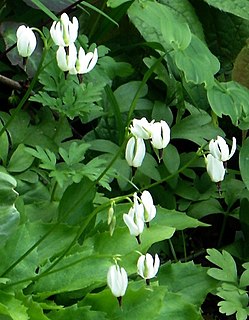
Primula latiloba, synonyms Dodecatheon dentatum and Dodecatheon latilobum, is a species of flowering plant in the family Primulaceae, known by the common names white shooting star and toothed American cowslip.

Primula austrofrigida, syn. Dodecatheon austrofrigidum, is a species of flowering plant in the primrose family known by the common names frigid shooting star and tundra shooting star. It is native to Washington and Oregon in the United States, where it grows in the coastal mountain ranges, including those on the Olympic Peninsula.
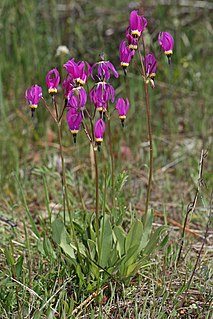
Primula poetica, synonym Dodecatheon poeticum, is commonly known as the poet's shooting star or the narcissus shooting star. P. poetica is a species of the genus Primula placed in section Dodecatheon. It is native to the states of Oregon and Washington in western North America. The section contains herbaceous flowering plants and is also a part of the primrose family Primulaceae. This plant has basal clumps of leaves and drooping flowers that occur at the apex of tall stems that rise from where the leaves join.
